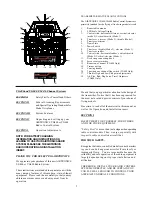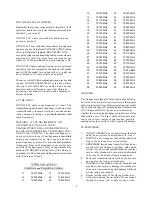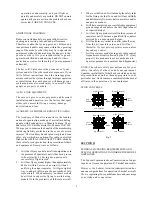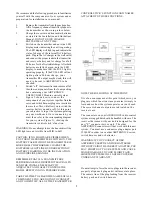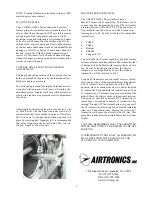
6
1.
Once you have followed the diagrams for
connecting the airborne components of your
VG400/VG600 FM radio control system and
you have studied and understood the diagram
illustrating the transmitter control stick
functions, you are ready to energize the
system and study its actual operation.
2.
Switch on the transmitter, then switch on the
airborne package. The system is now
energized. There maybe some initial
movement in the servos even though you have
not moved the transmitter sticks. THIS IS
NORMAL. Once they have found a position,
they will stay there.
3.
Now follow the diagram indicating the
transmitter’s control functions by moving
each stick and watching the reaction of the
servo or servos. Move the small black trim
levers and note the slight servo movements.
Keep these all centered through the
installation of your system in your model.
They will be used in actual flight or operation
of the model to adjust servo position
slightly…a process called “trimming”. If the
airborne system fails to operate, charge the
battery pack as outlined in the Battery
Charging Section of Installation and
Guidelines.
4.
Switch off the receiver, then switch off the
transmitter. GET USED TO THIS
SEQUENCE: When turning the system off,
TURN THE RECEIVER OFF FIRST, THEN
THE TRANSMITTER. When turning the
system on, the proper sequence is to TURN
ON THE TRANSMITTER THEN THE
RECEIVER.
SECTION V
FOR OPERATION AND ADJUSTMENTS
FOR SAFE AND SUCCESSFUL OPERATION OF
YOUR RADIO CONTROL MODEL, IT IS
IMPORTANT TO CAREFULLY FOLLOW THE
INSTRUCTIONS BELOW AND OBTAIN TRAINING
IN THE OPERATION OF YOUR MODEL FROM A
WELL-EXPERIENCED INDIVIDUAL.
At this point, having followed all of the instructions,
directions and guidelines contained in the earlier
sections of this manual and having completed your
model and installed your VG400/VG600system
observing the directions and guidelines contained in the
separate manual entitled “FUNDAMENTALS AND
GUIDELINES FOR INSTALLATION OF YOUR
AIRTRONICS SYSTEM”. We present here general
instructions concerning the process of learning to use
your VG400/VG600 System. Most of what is stated is
directed toward those using the system in a powered
model aircraft. However it is equally applicable to
sailplanes.
It should be re -emphasized that before you make initial
use of your completed model, you should have one or
more persons who are thoroughly experienced in the
field of radio controlled modeling completely go over
the mo del prior to your use to make certain you have
properly installed your VG400/VG600 system and
followed all of the directions given in this manual as
well as the Instruction Manual. We recommend that the
individual(s) who are “checking out” your model be
s h own these two manuals and that you and they review
all of the materials contained in them to make certain
that you have followed all directions and guidelines and
understand the warnings that have been given. This
should be done even if you are obtaining flight training
from experienced and competent flyers.
SERVO REVERSING:
The VG400/VG600 FM transmitters include servo
reversing on all channels. This feature makes it possible
to select the direction of the servo rotation of the
channels. Consequently, servo installation is greatly
simplified and the direction of the servo rotation
becomes unimportant. The servo reversing switches are
located in the front center of the transmitter faceplate.
THROTTLE END POINT ADJUSTMENT:
Both VG400 and VG600 have a new feature that will
allow you to set the high and low-throttle end points. By
moving the throttle stick to high-throttle, you can adjust
the TH-H adjustment clockwise to increase servo travel
or counter clockwise for less travel. For low-end
adjustment you will use the same sequence as just stated
but set the throttle stick to low throttle and use TH-L
adjuster.
SERVO TRAVEL VOLUME ADJUSTMENT (VG600
Only)
This new feature will allow you to adjust servo travel
for Aileron, Elevator, Aux Flaps and Rudder. M oving
the adjuster clockwise will increase total servo travel.
Moving the adjuster counter clockwise will decrease
total servo travel. This is very useful when setting up a
model for the first flight or you find you need more or
less control for the model aircraft.

